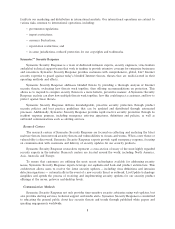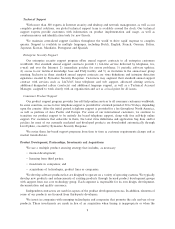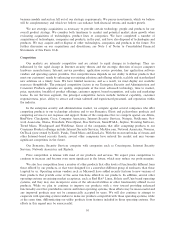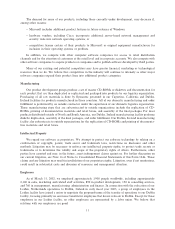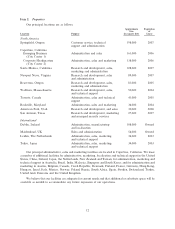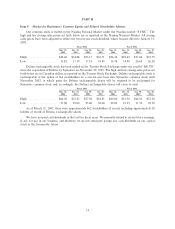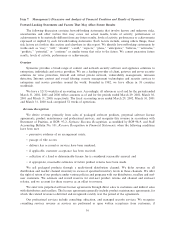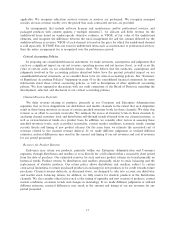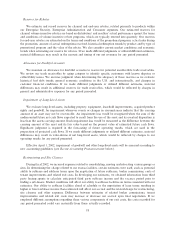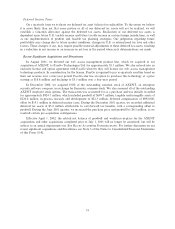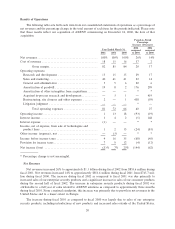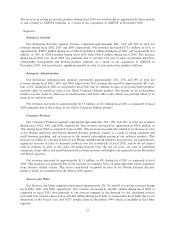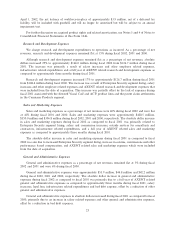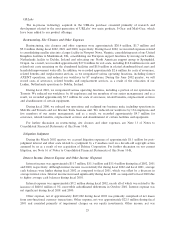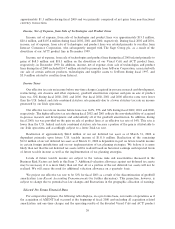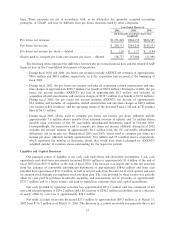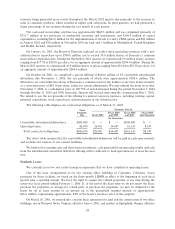Symantec 2002 Annual Report Download - page 40
Download and view the complete annual report
Please find page 40 of the 2002 Symantec annual report below. You can navigate through the pages in the report by either clicking on the pages listed below, or by using the keyword search tool below to find specific information within the annual report.Reserves for Rebates
We estimate and record reserves for channel and end-user rebates, related primarily to products within
our Enterprise Security, Enterprise Administration and Consumer segments. Our estimated reserves for
channel volume incentive rebates are based on distributors' and resellers' actual performance against the terms
and conditions of volume incentive rebate programs, which are typically entered into quarterly. Our reserves
for end-user rebates are estimated on the terms and conditions of the promotional program, actual sales during
the promotion, amount of actual redemptions received, historical redemption trends by product and by type of
promotional program and the value of the rebate. We also consider current market conditions and economic
trends when estimating our reserve for rebates. If we made diÅerent judgments or utilized diÅerent estimates,
material diÅerences may result in the amount and timing of our net revenues for any period presented.
Allowance for Doubtful Accounts
We maintain an allowance for doubtful accounts to reserve for potential uncollectible trade receivables.
We review our trade receivables by aging category to identify speciÑc customers with known disputes or
collectibility issues. We exercise judgment when determining the adequacy of these reserves as we evaluate
historical bad debt trends, general economic conditions in the U.S. and internationally, and changes in
customer Ñnancial conditions. If we made diÅerent judgments or utilized diÅerent estimates, material
diÅerences may result in additional reserves for trade receivables, which would be reÖected by charges in
general and administrative expenses for any period presented.
Impairment of Long-Lived Assets
We evaluate long-lived assets, including property, equipment, leasehold improvements, acquired product
rights and goodwill, for impairment whenever events or changes in circumstances indicate that the carrying
amount of an asset may not be recoverable. An impairment loss would be recognized when the sum of the
undiscounted future net cash Öows expected to result from the use of the asset and its eventual disposition is
less than the assets carrying amount. Such impairment loss would be measured as the diÅerence between the
carrying amount of the asset and its fair value based on the present value of estimated future cash Öows.
SigniÑcant judgment is required in the forecasting of future operating results, which are used in the
preparation of projected cash Öows. If we made diÅerent judgments or utilized diÅerent estimates, material
diÅerences may result in write-downs of net long-lived assets, which would be reÖected by charges to our
operating results for any period presented.
EÅective April 1, 2002, impairment of goodwill and other long-lived assets will be assessed according to
new accounting guidelines (see Recent Accounting Pronouncements below).
Restructuring and Site Closures
During Ñscal 2002, we incurred expenses related to consolidating, moving and relocating various groups or
sites. In determining the charge related to our excess facilities, certain estimates were used, such as potential
ability to sublease and sublease terms upon the negotiation of future subleases, broker commissions, costs of
tenant improvements and related exit costs. In developing our estimates, we obtained information from third
party leasing agents to calculate anticipated third party sublease income and the vacancy period prior to
Ñnding a sub-leasee. Market conditions will aÅect our ability to sublease facilities on terms consistent with our
estimates. Our ability to sublease facilities ahead of schedule or the negotiation of lease terms resulting in
higher or lower sublease income than estimated will aÅect our accrual and the related charge for restructuring,
site closures and other expenses. DiÅerence between estimates of related broker commissions, tenant
improvements and related exit costs may increase or decrease our accrual upon Ñnal negotiation. If we
employed diÅerent assumptions regarding these various components of our exit costs, the costs recorded for
any period presented could vary materially from those actually recorded.
18


